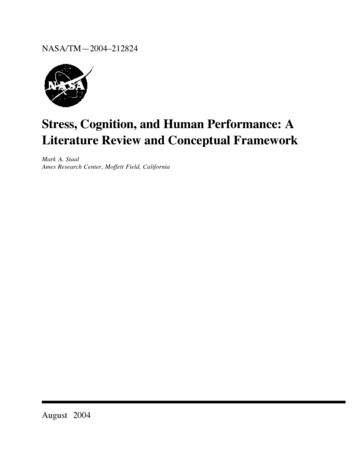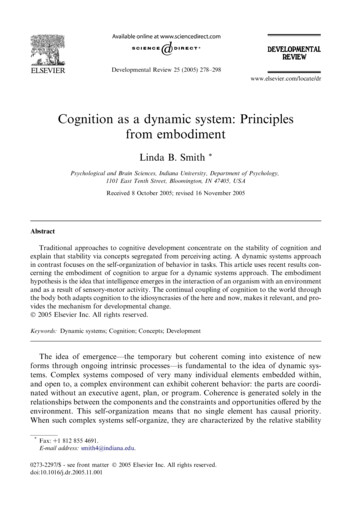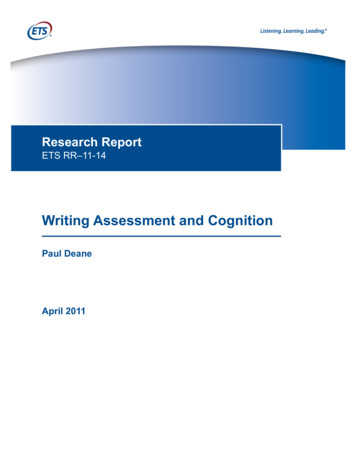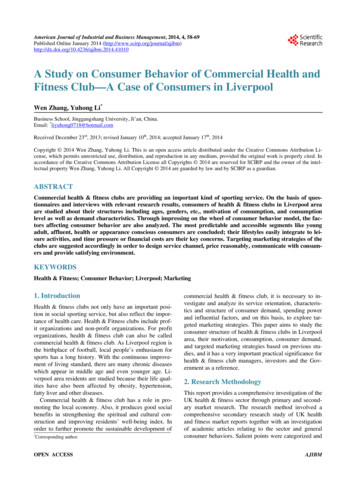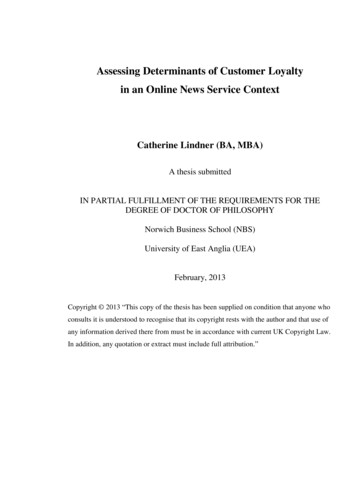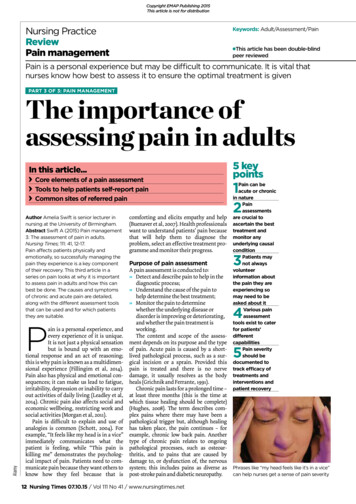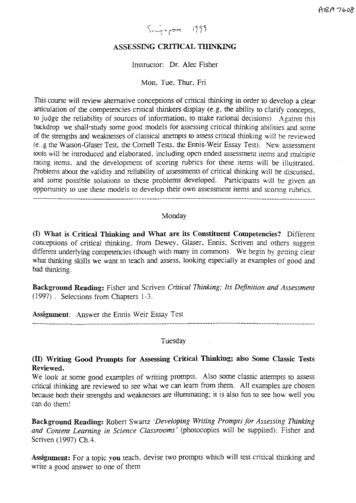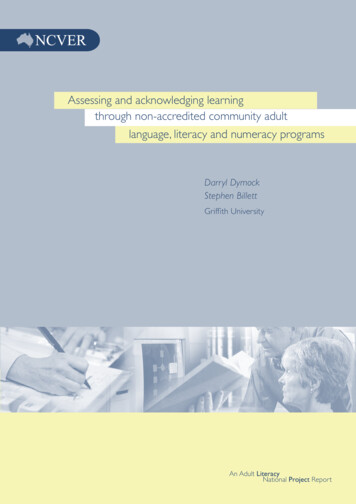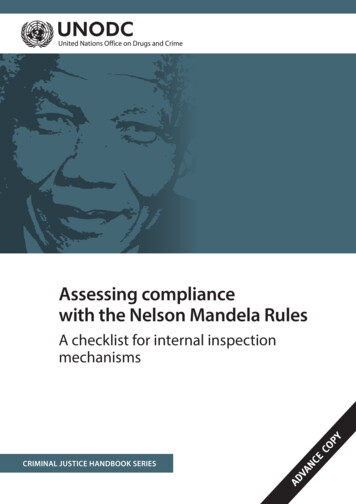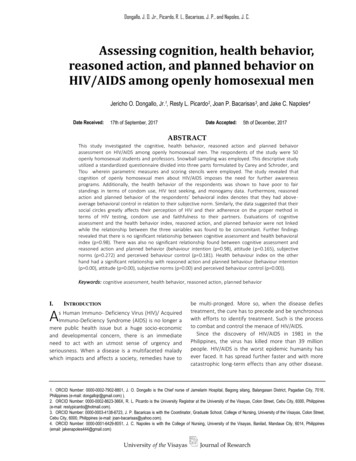
Transcription
Dongallo, J. O. Jr., Picardo, R. L., Bacarisas, J. P., and Napoles, J. C. Assessing cognition, health behavior,reasoned action, and planned behavior onHIV/AIDS among openly homosexual menJericho O. Dongallo, Jr.1, Resty L. Picardo2, Joan P. Bacarisas3, and Jake C. Napoles4Date Received:Date Accepted:17th of September, 20175th of December, 2017ABSTRACTThis study investigated the cognitive, health behavior, reasoned action and planned behaivorassessment on HIV/AIDS among openly homosexual men. The respondents of the study were 50openly homosexual students and professors. Snowball sampling was employed. This descriptive studyutilized a standardized questionnaire divided into three parts formulated by Carey and Schroder, andTlou wherein parametric measures and scoring stencils were employed. The study revealed thatcognition of openly homosexual men about HIV/AIDS imposes the need for further awarenessprograms. Additionally, the health behavior of the respondents was shown to have poor to fairstandings in terms of condom use, HIV test seeking, and monogamy data. Furthermore, reasonedaction and planned behavior of the respondents’ behavioral index denotes that they had aboveaverage behavioral control in relation to their subjective norm. Similarly, the data suggested that theirsocial circles greatly affects their perception of HIV and their adherence on the proper method interms of HIV testing, condom use and faithfulness to their partners. Evaluations of cognitiveassessment and the health behavior index, reasoned action, and planned behavior were not linkedwhile the relationship between the three variables was found to be concomitant. Further findingsrevealed that there is no significant relationship between cognitive assessment and health behavioralindex (p 0.98). There was also no significant relationship found between cognitive assessment andreasoned action and planned behavior (behaviour intention (p 0.98), attitude (p 0.165), subjectivenorms (p 0.272) and perceived behaviour control (p 0.181). Health behaviour index on the otherhand had a significant relationship with reasoned action and planned behaviour (behaviour intention(p 0.00), attitude (p 0.00), subjective norms (p 0.00) and perceived behaviour control (p 0.00)).Keywords: cognitive assessment, health behavior, reasoned action, planned behaviorI.INTRODUCTIONAs Human Immuno- Deficiency Virus (HIV)/ AcquiredImmuno-Deficiency Syndrome (AIDS) is no longer amere public health issue but a huge socio-economicand developmental concern, there is an immediateneed to act with an utmost sense of urgency andseriousness. When a disease is a multifaceted maladywhich impacts and affects a society, remedies have tobe multi-pronged. More so, when the disease defiestreatment, the cure has to precede and be synchronouswith efforts to identify treatment. Such is the processto combat and control the menace of HIV/AIDS.Since the discovery of HIV/AIDS in 1981 in thePhilippines, the virus has killed more than 39 millionpeople. HIV/AIDS is the worst epidemic humanity hasever faced. It has spread further faster and with morecatastrophic long-term effects than any other disease.1. ORCID Number: 0000-0002-7902-8801, J. O. Dongallo is the Chief nurse of Jamelarin Hospital, Bagong silang, Balangasan District, Pagadian City, 7016,Philippines (e-mail: dongallojr@gmail.com) ).2. ORCID Number: 0000-0002-8623-366X, R. L. Picardo is the University Registrar at the University of the Visayas, Colon Street, Cebu City, 6000, Philippines(e-mail: restypicardo@hotmail.com).3. ORCID Number: 0000-0003-4138-6723, J. P. Bacaricas is with the Coordinator, Graduate School, College of Nursing, University of the Visayas, Colon Street,Cebu City, 6000, Philippines (e-mail: joan-bacarisas@yahoo.com).4. ORCID Number: 0000-0001-6429-8051, J. C. Napoles is with the College of Nursing, University of the Visayas, Banilad, Mandaue City, 6014, Philippines(email: jakenapoles444@gmail.com)University of the VisayasJournal of Research
20Dongallo, J. O. Jr., Picardo, R. L., Bacarisas, J. P., and Napoles, J. C.Its impact has become a devastating obstacle todevelopment particularly with young people, who arethe key to any successful fight to halt HIV/AIDS throughawareness, prevention and education.For decades, the Philippines had dodged the globalAIDS crisis. However, things have now changed. There iscurrently a full-blown AIDS crisis in the country as seenin growing statistics. Tracing its beginnings in thePhilippines, HIV infection in the country was firstreported in 1984. Between January 1984 and July 2015,a total of 27,138 cases were reported, with the mostdramatic increase in the number of cases happening inthe past five years (Gonzales, 2016).In the Philippines, the National Youth Commission(NYC) recently noted that most of the new casesreported in the country are usually those of youngpeople, thus implying that the youth are mostly at riskof this disease which is steadily rising at epidemicproportions. Data from the Department of Health(DOH) reflects that 29 Filipinos get HIV every day. Ofthese 29 daily cases, 19 of these are between the agesof 15 to 25 years. In just one month in July 2015, therewere 682 new cases registered, 17% more than thesame month the previous year. Ninety-four percent ofthem were male and the average age was 27 (Dunuan,2016). As of October 2016, a total of 38,114 cases werealready on record.In terms of modes of transmission, the mostcommon was sexual contact (663 cases), and 86% ofthe sexually transmitted cases were among males whohave sex with males. The other modes of transmissionwere needle sharing among drug users (17 cases) andmother-to-child transmission (two cases) as studieshave shown (Dunuan, 2016).It is noted that Cebu City is ranked number one interms of prevalence of Human Immunodeficiency Virus(HIV) among all cities in the country, as stated by DOH7 Assistant Director Dr. Lakshmi Legaspi. According tohim, based on the most recent data, Cebu City reportedan HIV prevalence rate of 7.7%, ahead of Manila andQuezon City which logged 6.7% and 6.6%, respectively.The use of injectable drugs and needle-sharing havebeen tagged as the leading cause of HIV prevalence inCebu City, followed by males who engage in sex withmales, then by female entertainment or sex workers. InCentral Visayas, Cebu leads the provinces with 67persons confirmed to be living with AIDS, and 1,872others who have tested positive for HIV but have yet toshow or feel symptoms. Since 1984, at least 62 peoplefrom Central Visayas have died as a result of HIV/AIDS.Health officials have estimated that 16 Filipinos arepotentially infected with HIV per day. It is mostcommon among males aged between 15 and 40 yearsold (Destacamento, 2015).The current research emphasizes the importance ofthe three variables in understanding HIV among openlyhomosexual men—namely: the cognitive aspect, healthbehavior, reasoned actioned, and planned behaviour.The cognitive aspect refers to each respondent’sknowledge pertaining to HIV/AIDS prevention andtransmission. Thus, this is concerned with cognition ascontrasted with emotional and volitional processesamong homosexual men. Health behavior denotes tothe respondents’ conduct in relation to the preventionand transmission of HIV/AIDS. It is a function ofcompatible intentions and perceptions of behavioralcontrol in that the latter is expected to moderate theeffect of intention on behavior, such that a favourableintention produces the behavior only when perceivedbehavioral control is strong. Reasoned action andplanned behavior talks about how a person's conduct isdetermined by his/her intention to perform the saidbehaviour(s) and that this intention is, in turn, afunction of his attitude toward the behavior and hissubjective norm in relation to HIV/AIDS prevention andtransmission. Simply put, it is an indication of anindividual's readiness to perform a given behavior. It isassumed to be an immediate antecedent of behavior. Itis based on the person’s attitude toward the behavior,subjective norm, and perceived behavioral control, witheach predictor weighted for its importance in relationto the behavior and population of interest.The researchers would like to emphasize that thesevariables may be interrelated but somehow neglectedin some cases. For example, a person might beknowledgeable enough on HIV/AIDS prevention andtransmission but does not behave according to hisnature of understanding, or a person might be limitedin his knowledge but cautious enough to avoid riskybehavior. The theory of planned behavior in turnspecifies the nature of relationships between beliefsand attitudes. According to these models, people'sevaluations of, or attitudes toward behavior aredetermined by their accessible beliefs about thebehavior, where a belief is defined as the subjectiveprobability that the behavior will produce a certainoutcome. Specifically, the evaluation of each outcomecontributes to the attitude in direct proportion to theperson's subjective possibility that the behaviorproduces the outcome in question.According to the theory of reasoned action, if peopleevaluate the suggested behavior as positive (attitude),and if they think their significant others want them toperform the behavior (subjective norm), this results in aUVJOR2017 Volume 11 Issue 1
Dongallo, J. O. Jr., Picardo, R. L., Bacarisas, J. P., and Napoles, J. C.higher intention (motivations) and they are more likelyto perform the said behavior. A high correlation ofattitudes and subjective norms to behavioral intention,and subsequently to behavior, has been confirmed.The researchers are very much concerned about theincreasing statistics on HIV infection and AIDS. Aquestion can be posed as to why there is a growingpopulation of HIV infected individuals. Does theproblem lie in the information dissemination? Or is itdue to lack of information that preventive measuresfailed to realize? Something has to be done in responseto the growing statistics of HIV/AIDS cases in thecountry. Therefore, the current study aims to gain abetter understanding of the disease and providesubstantial information that may be used to prevent aparticularly vulnerable population—that is, openlyhomosexual males—from getting infected.Furthermore, this research aims to: (a) help in thedissemination of public awareness especially the youth;and (b) develop positive behavior geared towards theprevention of HIV/AIDS. Despite ardent efforts toproliferate awareness of this disease being made bygovernmental and non-governmental agencies,misconceptions among the public continue to outpaceefforts to educate people regarding the disease.As a general rule, the more favourable the attitudetoward behavior and subjective norm, and the greaterthe perceived behavioral control, the stronger theperson's intention to perform the behavior in questionshould be. Finally, given a sufficient degree of actualcontrol over the behavior, people are expected to carryout their intentions when the opportunity arises.II.THEORETICAL FRAMEWORKThe study is anchored on the theory of reasonedaction (TRA) and the theory of planned behavior (TpB)by Ajzen and Fishbein (1980). TRA was first introducedin 1967 by Fishbein in an effort to understand therelationship between attitude and behavior. It attemptsto explain the relationship between beliefs, attitudes,intentions and behavior. According to the theory ofreasoned action, the most accurate determinant ofbehavior is behavioral intention. The directdeterminants of people’s behavioral intentions are theirattitudes towards performing the behavior and thesubjective norms associated with the behavior. Attitudeis determined by a person’s beliefs about the outcomesor attributes of performing a specific behavior (that is,behavioral beliefs), weighted by evaluations of thoseoutcomes or attributes. The subjective norm of aperson is determined by whether important referents(that is, people who are important to the person)University of the Visayas21approve or disapprove of the performance of abehavior (that is, normative beliefs), weighted by theperson’s motivation to comply with those referents(Ajzen & Fishbein, 1980; Montano & Kasprzyk, 2002).According to Montano and Kasprzyk (2002), the theoryof reasoned action is successful in explaining behaviorwhen volitional control is high. In conditions wherevolitional control is low, the theory of planned behavior(Ajzen, 1991) is more appropriate to explainingbehavior (Tlou, 2009).Later developments in the field led to the conclusionthat behavior appeared not to be 100 % voluntary andunder control. This perspective resulted in the additionof “perceived behavioral control” as a new concept.With this addition the theory evolved into what wascalled the theory of planned behavior (TpB).TpB, on the other hand, holds that only specificattitudes toward the behavior in question can beexpected to predict that behavior. In addition tomeasuring attitudes toward the behavior, we also needto measure people’s subjective norms – their beliefsabout how people they care about will view thebehavior in question. To predict someone’s intentions,knowing these beliefs can be as important as knowingthe person’s attitudes. Finally, it is also acknowledgedthat perceived behavioral control influences intentions.Perceived behavioral control refers to people'sperceptions of their ability to perform a given behavior.These predictors lead to intention. A general rule, themore favorable the attitude and the subjective norm,and the greater the perceived control the strongershould the person’s intention to perform the behaviorin question (Ajzen, 1991).According to the theory of planned behavior,perceived behavioral control is determined by controlbeliefs concerning the presence or absence offacilitators and barriers to behavioral performance,weighted by the perceived power or input of eachfactor to facilitate or inhibit behavior. Thus, a personwho holds strong control beliefs about
University of the Visayas Journal of Research . ORCID Number: 0000-0003-4138-6723, J. P. Bacaricas is with the Coordinator, Graduate School, College of Nursing, University of the Visayas, Colon Street, Cebu City, 6000, Philippines (e-mail: joan-bacarisas@yahoo.com). 4. ORCID Number: 0000-0001-6429-8051, J. C. Napoles is with the College of Nursing, University of the Visayas,

